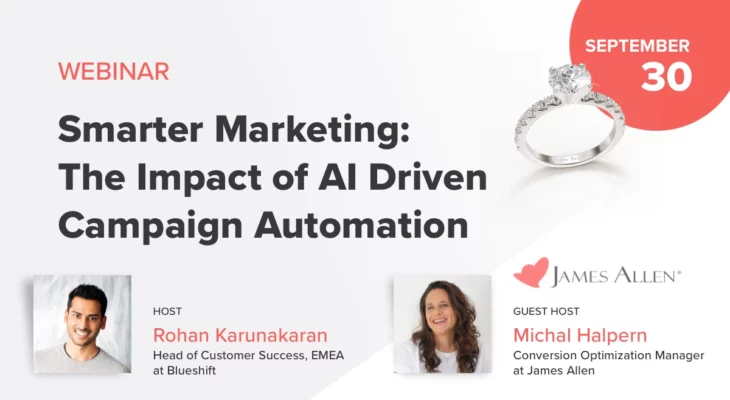In order to have smarter marketing automation you need a few ingredients:
- A strategy/vision of what you’re trying to accomplish
- Access to customer data
- Tools that give you the ability to execute campaigns against that data and strategy
Let’s hear more from Michal, who has implemented this at James Allen.
Rohan: How did James Allen identify Smart Marketing Automation was a need?
Michal: James Allen’s vision is to understand the customer experience and have deeper personalization based on their interaction with our brand. Access to accurate and real-time customer data is important so we can develop personalized campaigns using customer’s behavioral data, affinities, and preferences. When I started working at James Allen (4 years ago) we were using 2 different email platforms; one for behavioral campaigns and one for bulk campaigns. These 2 platforms were not integrated, and I had no ability to view the customers’ journey from sign-up to purchase across our website or email campaigns. This was my first goal — find 1 platform that gives us the option to track the customer’s journey properly and suggest products accordingly.
The next step was to ensure we’re showing the most accurate content (product recommendations) to customers based on interactions with our brand.
Rohan: What types of campaigns are you running using this mindset and technology?
Michal: Buying an engagement ring online is not an easy process and most of the time needs to be done discreetly. In our welcome series cycle (divided into male and female with different content per gender) we educate the customer and guide them along with their long and complicated choice. This requires the right balance of delivering tailored product recommendations while being discreet and respectful in our approach.
One of our best performing campaigns is our behavioral campaigns that are triggered based on website activity and catalog activity such as window shopping, abandoned carts, new arrivals, and best sellers. We know it’s a highly considered purchase decision for most of our customers, that’s why we give a big emphasis on guiding our customers and being patient throughout the customer journey. We typically see a long purchase cycle and to convert customers, we try to understand if they are buying for themselves or their partner. This data helps us target and deliver the best content and product recommendations.
Rohan: What does the James Allen team look like that can do this type of work? Are you a team of data scientists or a team of marketers?
Michal: James Allen’s email team is a combination of data-driven marketers that use data to inform every step of our marketing process. Every email has at least 2 touchpoints before it’s sent: our emails are written by a content writer and once that’s approved, the email moves onto a designer. And finally, our team decides on the themes of the emails — typically our decisions are based on results from previous emails/campaigns. My team and I have a good knowledge of HTML and all our emails are being worked in HTML first. That gives us a lot of flexibility for adding recommendations and product suggestions in the HTML of the email.
We’re a small but mighty team of marketers. It’s important for us to have a dynamic email platform that allows us to build granular segments, dynamic product recommendations, and multi-channel campaigns. It’s not only looking at the numbers, it’s all about being up-to-date with the industry and competitors, while also knowing how to transform data into great marketing that will engage our customers and guide them towards a purchase. We know we can get even more sophisticated and personalized with our campaigns, and we’re looking forward to using some of the more advanced features of the platform.
Rohan: How has Blueshift impacted James Allen? What results have you seen?
Michal: Since implementing Blueshift we have more ability and plans to improve our email campaigns and personalize every customer’s journey. I can share that we managed to deliver more personalized experiences based on affinities to certain diamond styles, jewelry types, and more which resulted in a 17% increase in website sessions from email traffic. We also increased our message volume by 27%, with the same amount of resources.
To wrap up, Rohan’s final suggestions is to look at your current marketing campaigns and determine where you are using marketing automation but need to incorporate the smart component. Then identify what data you have access to across your organization that you want to leverage for those use cases and investigate the feasibility of pulling that data into one place. Finally, if needed, evaluate your technology to make sure you have the tools you need.



